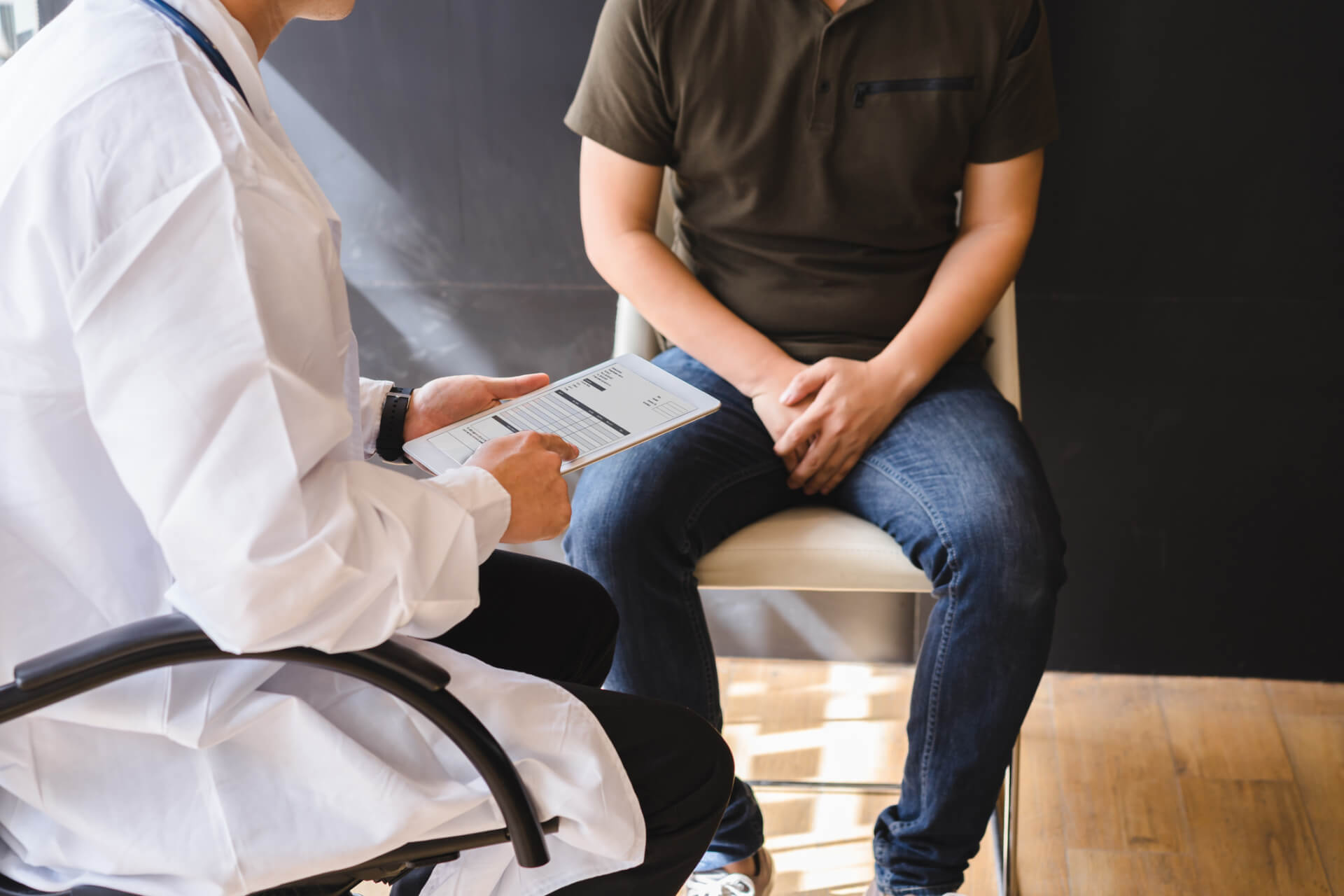A varicocele is an enlarged vein in the excess skin sack that supports the testicles (scrotum). Varicocele is similar to the type of varicose vein that is visible in the leg. The majority of varicoceles increase over time. Fortunately, most of these varicoceles are easy to detect, and many don’t require treatment. If a testicular varicose vein produces symptoms, a varicocele surgery can help resolve it.
So what are the most common symptoms and causes of testicular varicose veins? Varicoceles are varicose veins that bulge and lose their form similar to the veins in the legs. Varicoceles are commonly painless, and a lump in one of the testicles is one of the major symptoms. A swelling scrotum is due to enlarged or twisted veins that resemble a bag of worms; this may cause dull discomfort and recurring pain.
What Causes Testicular Vein?
The causes of varicocele are unknown to doctors. One major cause could be a disturbance in blood flow in the spermatic cord, which transports blood to and from the testicles. If the pampiniform plexus inside the spermatic cord doesn’t operate properly, the blood backs up, resulting in a dilated vein.
A spermatic cord supports both the right and left testicle. The gonadal vein drains gonads via a spermatic cord to the renal vein. The valves in the veins keep blood flowing in just one direction: to the heart. Blood backs up and produces a varicocele when a valve in the spermatic cord does not seal properly.
Varicoceles are common in adolescent boys as a result of their rapid growth during puberty. As the testicles grow, they require more blood than usual, and any trouble with pampiniform plexus can prevent the blood from going where it should go.
If the testicle is swelling, this could be a hydrocele. The surrounding fluid inside the testicle causes this condition, and a patient should seek medical assistance. In detecting varicoceles, an interventional radiologist will perform a combination of assessments.
These evaluations may include scrotal ultrasound, clinical semen analysis, and MRI of the testicular veins from the origin. It is possible to identify the size and extent of an affected vein using these methods.
If it is not symptomatic varicoceles, they can be left alone. Varicocele treatment may be necessary if there are fertility concerns or if there is scrotal pain. An interruption of blood flow in a healthy vein, like any other organ, can potentially cause malfunctions.
Varicoceles are classified as follows:
Pressure type. A grade I varicocele develops when a blood clot is in the spermatic vein.
Shunt type. A severe build-up damages the pampiniform plexus in the spermatic cord. That results in a swollen vein, grade II or III varicoceles. It is most likely that it will impact the left testicle even if a varicocele is present on one side. It might still affect sperm count on both testicles.
Secondary varicocele. Increased pressure in the testicular vein causes secondary varicocele. A variety of diseases like hydronephrosis may trigger this condition. It also involves compression of the left renal vein between the superior mesenteric artery and the aorta.
Understanding the Symptoms of Testicular Varicose Vein (Varicocele)
A varicocele may not cause any symptoms at all. Nonetheless, a patient may encounter the following:
- testicle lump
- scrotum swelling
- a visibly enlarged or twisted blood vessel in the scrotum that looks like a bag of worms
- dull, recurring scrotal pain
Varicoceles affect around 10% of all males. Nevertheless, the frequency of varicoceles among infertile partners rises to 30%. Men between the ages of 15 and 35 had the highest rate of incidence. As many as 70-80,000 men in the United States undergo varicocele surgery each year.
Additional symptoms are as follows:
Fertility Issues. Varicoceles and infertility are linked to each other. Infertile couples have a 30 percent higher chance of developing varicocele. An increased amount of malformed sperm, lower sperm count, reduced sperm motility are associated with varicoceles.
According to some specialists, blocked and swollen veins around the testes induce infertility by boosting the temperature in the scrotum and reducing sperm production.
Pain. When a person stands or sits for lengthy periods, pressure builds up in the afflicted veins, causing intense pain. Painful varicoceles are usually bigger and noticeable.
Testicular Atrophy. It refers to the shrinking of the testicles. When a testicle is healed, it usually returns to its original size.
Diagnosis is either through some physical examinations or diagnostic analysis.
- Commonly seen on the left testicle.
- Visual physical examination — shows a “bag of worms” in the scrotum.
- A non-invasive imaging test detects an abnormal vein when varicoceles are not visible. It is color Doppler ultrasound; it involves injecting a specific dye to “highlight” blood vessel abnormalities.
Treatments for Varicocele
A varicocele does not necessarily require treatment. However, if a patient should consider a varicocele treatment if it causes the following:
- testicular atrophy
- infertility
- pain
- considering reproductive procedures
Some people may experience issues with testicular function as a result of this disorder. The sooner a patient begins treatment, the greater the prospects of increasing sperm count will be.
Tight underwear or a jockstrap can occasionally provide support patients need to relieve pain or discomfort. If the symptoms worsen in an affected testicle, additional therapies are necessary. These treatments are varicocele ligation, microsurgical varicocelectomy, and varicocele embolization.
Varicocele embolization is a less invasive surgery that can be done within the day. A vein doctor will place a catheter into a normal vein in the groin or neck. Following that, a coil is inserted into the catheter and the varicocele. The treatment blocks the blood towards the abnormal veins.
Varicocele ligation is a procedure that has a short recovery time and minimal post-operative discomfort. The ligated testicular veins will produce new veins from the lymphatic channels. The ligation will help ease the testicle’s venous congestion, alleviate pain and boost sperm production.
Microsurgical varicocelectomy is a surgical treatment that removes bulging veins in the scrotum. Varicoceles are more common on the left side of the body, yet they have no symptoms or indicators. The method uses a microscope to surgically mend swollen veins by small incisions (an inch or less). Varicocelectomy is an outpatient treatment with less downtime. A patient can return home right after finishing the procedure.
Life With a Testicular Varicose Vein
Infertility is a prevalent complication of varicocele. If couples are having trouble getting pregnant, speak to a doctor about meeting a reproductive professional.
If a patient is having painful varicoceles or trying to have a child, surgery is needed. However, a varicocele rupture that results in an intense scrotal hematoma is a rare occurrence. Consult a doctor to determine which treatment is the best option.
Read more: How to Treat Vaginal Varicose Veins
Have an Expert Treatment on Varicocele at Vein Center Doctor
While varicoceles are seldom serious, they are the major source of concern for some men. We provide non-surgical aesthetic therapies at Vein Center Doctor to assist clients in getting rid of testicular varicose veins.
Our team of professionals recommends several treatments for damaged and abnormal veins in various sections of the body. Book an appointment today to learn more about the treatment that’s best for you.





